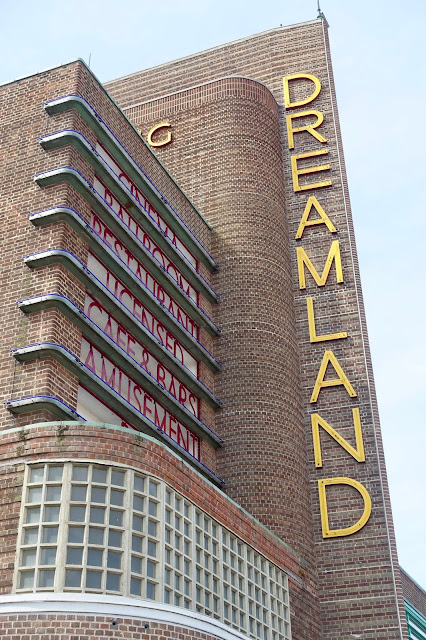Margate is a a town of just over 60,000 people on the Kent coast. Every summer it attracts thousands of day trippers, most of whom will have been greeted at the station by a representative of Dreamland, a large entertainment complex and visitor attraction on the seafront. Today Dreamland encompasses a fairground, roller room, crazy golf, concerts and shows and a range of family orientated activity. The site was originally home to the Dreamland Variety Theatre which opened in 1923 and could seat 900. Later renamed the Dreamland Cinema it was adjacent to an amusement park of the same name.
The Dreamland Super Cinema opened on the same site in 1935 and quickly became a landmark building in the town. The Painted Veil starring Greta Garbo based on the W. Somerset Maugham novel of the same name was the first film to be screened there in March 1935. Architects Julian Rudolph Leathart and W.F. Granger designed the cinema, the design of which was strongly influenced by German expressionism. Dreamland was perhaps the first art deco cinema to have a brick expressionist exterior which culminated with an 80 foot tower with a dramatic projecting fin. The asymmetrical facade also included crittal glazing and stylised lettering originally lettering applied in sans-serif with neon strips. Unfortunately this has been lost. The fin ensured that the cinema could be seen from some distance along the shoreline whilst the interior boasted an ultra modern sound system, an organ, bars, a ballroom, a 500 seat restaurant and a cafe with views out to sea. The cafe originally had a large mural of a sea serpent designed by Walpole Champneys. English heritage report the mural as being lost.
2050 customers could be seated at any one time with 1,328 seats in the stalls and 722 on the balcony. The interior was designed by John Bird-Iles whilst Eric Aumonier sculpted sea-nymphs set into recesses at each side of the auditorium. Bird-Iles was the son of the complex whilst Aumonier was also responsible for the kneeling archer at London's East Finchley Underground Station.
The cinema was closed in 1940 due to the Second World War. In the same year it received troops evacuated from Dunkirk. It did not reopen until July 1946. Significant changes were made to the design in 1973 when two more screens were added in the balcony space. The stalls and stage were converted to a theatre but failed to attract audiences and closed just two years later in 1975 and was the used as a bingo hall. In 1981 a third, smaller screen was added, with seating for just 60 people. This was to operate for 12 years before closing in 1993 as part of a series of changes made by the new, Dutch owners. The bingo hall closed in 2006 whilst the other two screens managed by Reeltime Cinemas held on until the following year when they too ceased operating.
The building was awarded Grade II listed status in 1992 before being upgraded to Grade II* in 2008. Major restoration of the exterior began in 2011 and were completed in 2017. The restored building once again stands proudly on Margate's promenade and I understand that there are plans to introduce open air screenings in the complex this summer.




No comments:
Post a Comment